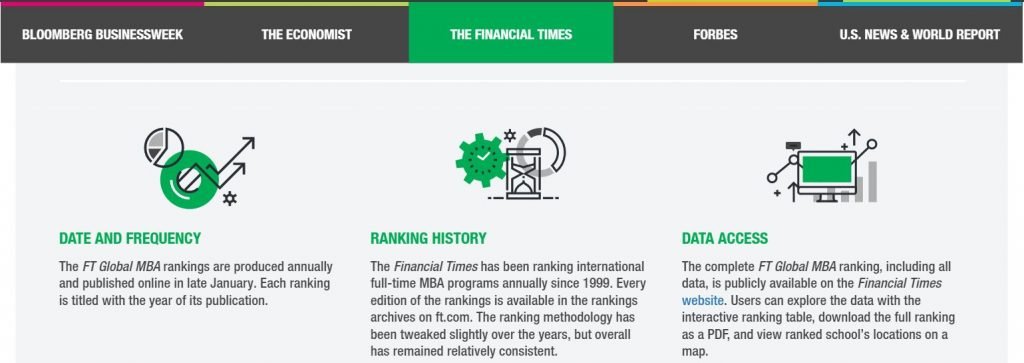In their most recent rankings, U.S. News & World Report and Bloomberg BusinessWeek named Harvard Business School the number one business school around. But wait…according to the Economist, the University of Chicago Booth School of Business gets top bragging rights. And then there’s the Financial Times, which names INSEAD number one, and Forbes, which says it’s Stanford Graduate School of Business. Confused yet?
Many applicants to business school look to rankings as a way to make sense of the many different choices that exist for getting an MBA—but making sense of the many different rankings is in itself a challenge. Good news. The Graduate Management Admission Council (GMAC) has put together a comprehensive online tool designed to help make it clear just how each publication decides which schools come out on top—based on what factors weighted how. Unveiled yesterday, the User’s Guide to Full-Time MBA Rankings can be found on GMAC’s student-facing website at mba.com/rankings.
“Though rankings exist to provide useful information to judge the quality of MBA programs, the existence of multiple rankings contributes to confusion among applicants,” Sangeet Chowfla, president and CEO of GMAC, said in a statement announcing the new tool. “We created this resource to clarify the differences among the various rankings, as no one ranking methodology can speak to the individual needs and aspirations of every candidate considering a business degree.”
Indeed, the array of rankings have emerged because they each measure different data points and assign them different weights—which helps explain why the results can vary so widely from publication to publication. GMAC, with its new resource, has set out to a break down the methodologies used by each ranking publication, clearly identifying the distinctive aspects of each one. Understanding these methodologies—and how they align with what you consider most important about the MBA—can help applicants use rankings more strategically.
Breaks Down Each Publication’s Methodology, Distinctive Emphasis
The User’s Guide to Full-Time MBA Rankings breaks down how each of the methodologies assigns weight across 14 standardized weighting categories. Not only that, interactive tree maps let users clearly see how much weight each ranking places on each category, and users can toggle between fact-based and opinion-based indicators using a responsive sliding scale.
The guide also defines the distinctive emphasis of each ranking. For Forbes, for example, the distinctive emphasis is on return on investment, with the entire methodology based on how the cost of the program compares to alumni earnings five years out. The Economist, in contrast, has as its distinctive emphasis career services and networking—its methodology weights those factors 15 and 10 percent respectively, much more so than any other publications, many of which do not take these things into consideration at all.
Spotlights Volatility
Another potentially confounding aspect of rankings can be their volatility. A number-one ranked school can plummet several spots over the course of a single year, often for reasons that don’t actually reflect such a dramatic change in the quality of education the school provides to students in its MBA program. The GMAC tool attempts to demystify this somewhat by analyzing the last two years’ editions of each ranking and measuring the average school’s position change, both overall and specifically among the top 20 ranked schools.
“Since rankings change year to year, candidates should only consider them as one aspect in their decision-making process,” Chowfla added, echoing a point we strive to make each time we report the findings of any rankings here on Clear Admit.

In addition to the features mentioned above, the new GMAC guide to rankings also compiles in one place a description of which schools are included in each publication’s full-time MBA ranking; GMAC data on how many students around the world use each ranking and how influential it is to their decision making, when and how frequently each ranking is published (pictured in opening image), how users can access the data and a brief history of how each ranking got its start. While its focus is on the full-time MBA rankings for each of the five publications, it also provides a list of any additional business school rankings they also produce.
Check out the new User’s Guide to Full-Time MBA Rankings from GMAC for yourself.




